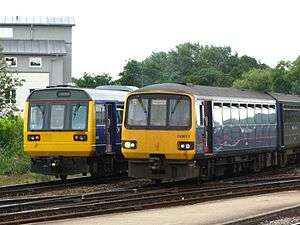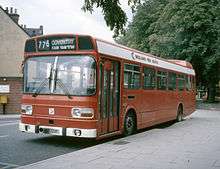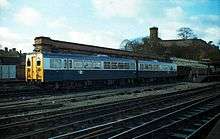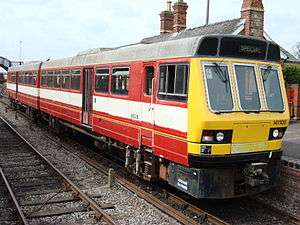Pacer (train)
| Pacer | |
|---|---|
 | |
| In service | 1984–present |
| Family name | Pacer |
| Constructed | 1984–87 |
| Number built | 165 trainsets |
| Number in service | 140 trainsets |
| Number scrapped | 7 trainsets |
| Operator(s) |
Current: Great Western Railway Northern Transport for Wales Former: Regional Railways Arriva Trains Northern Valley Lines Wales & Borders Northern Rail Islamic Republic of Iran Railways (1997–2005) |
| Specifications | |
| Track gauge | 4 ft 8 1⁄2 in (1,435 mm) |
Pacer is the operational name of the British Rail Classes 140, 141, 142, 143 and 144 diesel multiple unit railbuses, built between 1980 and 1987. Intended as a short-term solution to a shortage of rolling stock (with a lifespan of no more than 20 years), but as of 2018, many Pacer railbuses are still in use.[1]
It is expected that Pacer trains will all be retired by the end of 2019. The Rail Vehicle Accessibility Regulations require that all public passenger trains must be accessible to disabled people by 2020. Only one Pacer (the modernised 144e) currently meets this requirement, and the remainder will therefore need to be withdrawn by that date unless they receive an extensive refurbishment. Furthermore, a ministerial directive in 2015 by the Transport Secretary required that such railbuses were removed from service by 2020 for the new Northern franchise stating that the "continued use of these uncomfortable and low-quality vehicles is not compatible with our vision for economic growth and prosperity in the north."[2]
As of August 2018, 140 units are still in service with three franchises: Northern, GWR and Transport for Wales. They will predominantly be replaced by cascaded diesel trains which have been supplanted by new-build trains on other lines.
Features

The Pacer series were built with low construction and running costs in mind, and so all of the Pacer units feature the following:[3][4]
- The use of a lightweight modified bus body and other bus components, such as seating, with a reinforced drivers-cab area to comply with crashworthiness standards.
- The use of a long-wheelbase four-wheel freight-wagon inspired underframe, rather than the more usual arrangement of two four-wheeled bogies. This arrangement has been criticised for rough-riding, and causing loud noise and excessive wear to the wheels and track on tight curves.
Background
At the beginning of the 1980s British Rail (BR) needed to produce new trains to replace their ageing fleets of first generation diesel multiple units (DMUs) which had been built between the mid-1950s and early-1960s. These first generation units had helped replace steam and had, when introduced, proved popular with the public. At the time BR was under severe financial pressure from the government and lacked the money to replace all of them with units of similar quality. BR developed two different types of units as second generation replacements: The 'Sprinter' series, as conventional DMUs for use on urban and longer-distance services, and the 'Pacer' series as low-cost DMUs built using bus parts and intended for short-distance rural and branch line services.[5][6] The Pacers were originally intended as a low-cost stopgap solution to the rolling stock shortage, with a maximum lifespan of 20 years.[3] BR set a challenge to several companies to design a cheap, lightweight train similar to railbuses. Since then, 165 Pacer trains (totalling 340 carriages) have been built; by 2015, some of these were over 30 years old.
Demonstrator units toured the U.S., Northern Ireland, Belgium, Sweden, Thailand, Malaysia and Indonesia, without producing sales. However Iran purchased redundant Class 141 units, for use on suburban lines around Tehran until 2005.[5]
Class 140

The Pacer series was the result of an experiment to see whether the possibility of using bus parts to create a diesel multiple unit was viable. The initial prototype, known as LEV-1, was a joint project by the British Rail Research Division and Leyland Motors using a bus body mounted on a modification of an existing freight vehicle underframe (HSFV1). This was followed by the two-car prototype class 140, which was built in 1980 at British Rail Engineering Limited (BREL)'s Derby Litchurch Lane Works.
Class 141

The prototype was joined by another 20 two-car units which formed the Class 141 fleet. The units were used mainly in Yorkshire, operating on predominantly suburban services. They had a capacity of 94 passengers per two-car set, and two Leyland TL11 engines gave a total of 410 bhp (310 kW), resulting in a top speed of 75 miles per hour (121 km/h). The entire class underwent a technical upgrade in 1988 at the Hunslet-Barclay works in Kilmarnock. The units were withdrawn from use in 1997. Many were sold to Islamic Republic of Iran Railways[7] but have been withdrawn and are left rotting away in disused sidings in Iran,[8] whilst a few remain in preservation. Because it used a standard Leyland National body, the Class 141 was narrower than the later Pacers, and could therefore accommodate only standard bus seating. The later Pacers had widened body panels to allow an increase in seating.
Class 142
.jpg)
The next and largest Pacer class was the Class 142. This again was built by Leyland and BREL, in 1985. The body was based on a Leyland National bus, built at Lillyhall, Workington in Cumbria. Many fixtures and fittings of the Leyland National could be found on the units. The new class had a greater capacity of 120 passengers per two-car set and the same engines were used. The first sets were used initially on Devon and Cornwall branch lines and on commuter services in the North West. The units from Cornwall were eventually moved to Liverpool and the North East, and the Class 142s have become a common sight on services across the North of England. The class was upgraded in the early 1990s to include more powerful Cummins engines, which gave a total power output of 460 bhp (340 kW) per two-car set. A number of units were then modified for use on the Merseyside PTE City Line on Merseyrail in the Liverpool region, which included dot-matrix route indicators, improved seating and Merseyrail PTE paintwork. This class moved into the control of First North Western at privatisation, and subsequently passed on to Northern Rail and Arriva Trains Wales, which have since operated it. Eight units were temporarily withdrawn from service, replaced by a cascading of British Rail Class 158s.[9] First Great Western received 12 units on loan from Northern Rail from December 2007 to November 2011 (5 units were returned to Northern in December 2008) to cover for refurbishment of their fleet and to allow most of their Class 158 fleet to be rebuilt as 3-car sets.
Class 143 & Class 144
Around the same time of the Class 142 development, a Pacer railbus was being developed by Kilmarnock-based Hunslet-Barclay. The units used a Walter Alexander bus body. The units were given the number Class 143 and entered service in 1985. Again with two 205 bhp engines giving a total output of 410 bhp (310 kW) and a top speed of 75 mph (121 km/h), the class originally had a capacity of 122 passengers. The class was used in the North East before being transferred to Wales and the South West, and were moved over to Wales & West control during privatisation. They then passed on to Arriva Trains Wales and Wessex Trains, which later became part of the Greater Western franchise. The interiors were completely changed in 2000, when the Valley Lines service was introduced, with full back, coach-type seating installed throughout, along with improved fittings. This reduced seating capacity to 106 seats per set.
Then came a similar Class 144 unit, a Walter Alexander body on BREL underframe, which was introduced in 1987. A unit was formed of either a two-car set with 122 seats or a three-car set with a total capacity of 195 passengers and 690 bhp (510 kW), though still limited to 75 mph (121 km/h). The units were used in the North East, passing to Northern Spirit at privatisation, then to Arriva Trains Northern, Northern Rail and now Northern.
Advantages and disadvantages
The Pacers have been widely criticised as poor quality. Instead of the more usual bogies, Pacers use a basic four-wheel two-axle configuration which often results in a ride which is noisier and less comfortable than other trains. The lack of articulation can result in a rough ride, especially over points, and a loud squealing noise around tight curves. The lack of bogies also results in a more basic suspension, which can result in a bouncy ride; this has given rise to the nickname "nodding donkeys" owing to the trains' up-and-down motion on uneven track. The basic bench seating can also be uncomfortable.[3] The early units especially the Class 141's were also notoriously unreliable.[5]
The fact that Pacers have only been used in certain areas of the North and South West of England and Wales, but not London or South East England has also led to resentment.[3][5]
On the other hand the Pacers have been praised as a pragmatic solution at a time when budgets were tight, and have been credited with saving services on some rural lines which might otherwise have been withdrawn had only more expensive rolling stock been available.[3] They have also proved economic to operate, achieving a fuel economy of 10 miles to the gallon.[5]
Concerns were raised about safety after the 1999 Winsford crash,[10] which involved a First North Western Class 142 colliding with the rear of a Virgin Trains Class 87 and empty coaching stock at Winsford, Cheshire on the West Coast Main Line.[11] The body of the Pacer was severed from its frame, to which it was attached by wire straps, causing severe internal damage; the unit was written off. Twenty-seven passengers and crew were injured, four seriously. However, all passenger injuries were on the other trains, as the Class 142 was running empty at the time. [12]
Replacements

As of 2018, the oldest Pacers were 33 years old. Because of the electrification programme approved from May 2011 to 2014, Class 142s will all be withdrawn and scrapped by 2020; it is possible that some of the remaining trains will receive lifespan extensions and wheelchair accessibility upgrades, which means these trains could continue to run until 2032. Porterbrook, which owns the Class 143 and Class 144 fleets, has proposed such a refurbishment for the rest of the fleet,[13] while Angel Trains, which owns the Class 142 fleet, does not see such a refurbishment as a viable option.[14]
A proposed replacement train is being designed by the Stratford upon Avon-based rolling stock manufacturer Vivarail, which plans to market a new class of DMU called the D-Train. These units will be built out of upcycled London Underground D78 Stock, which had previously been in service on the District line. Conversion of the old Underground stock to heavy rail use will involve re-using the aluminium bodyshells, traction motors and bogies from the D78 units and fitting them out with new diesel engines and interiors. The D-Train units are undergoing acceptance testing in 2015 and Vivarail plans to pitch them to train operating companies (TOCs), especially those bidding for the Northern franchise, which was awarded in December 2015.[15] However, the new operator, Arriva Rail North, has announced it will instead replace the Pacers with brand new Class 195 CAF Civitys.[16] In October 2017, West Midlands Trains announced that it had ordered 3 D-Train units for the West Midlands franchise that it will take over in December 2017.[17]
Pacer preservation
Although most Pacer railbuses of the British Rail Classes 142, 143 and 144 are still in use on the UK rail network, at least three units of the British Rail Class 141 fleet have so far been preserved for tourism use on heritage railways. The National Railway Museum in York has expressed an intention to preserve 142001.
References
- ↑ Alan Whitehouse (21 October 2011). "Long-term safety fears over Yorkshire's Pacer trains". BBC News.
- ↑ "New trains to replace north of England's ageing rolling stock by 2020". The Guardian. 27 February 2015.
- 1 2 3 4 5 Kelly, Jon (7 March 2016). "Pacers: The train that the UK has struggled to get rid of". BBC News Magazine. Retrieved 5 June 2018.
- ↑ Rail Projects : The BRE-Leyland Pacers – the dream becomes a nightmare - www.aronline.co.uk
- 1 2 3 4 5 Simon Bradley (17 October 2015). "Will Pacer trains trundle into history at last?". Yorkshire Post. Retrieved 19 October 2015.
- ↑ St John Thomas, David; Whitehouse, Patrick (1990). BR in the Eighties. Newton Abbot: David & Charles. ISBN 0-7153-9854-7.
- ↑ "Iranian Railways Rolling Stock". Archived from the original on 28 September 2011.
- ↑ http://share.bahnforum.info/transfer/e825dbc060ecc7caa98ce2687fe5a58c9db17011/Iran_2013/IMG_2301_1.JPG
- ↑ "Angel Trains leases 30 Class 158 diesel multiple units to Northern Rail" (PDF). Northern Rail (Serco-Abellio)Northern Rail. 13 March 2007.
- ↑ "Safety fears over commuter trains". BBC News. 2 July 1999.
- ↑ "Train driver averts disaster". BBC News. 23 June 1999.
- ↑ "Report by the Health and Safety Executive's Railway Inspectorate into the train accident at Winsford South Junction on 23 June 1999" (PDF). Health and Safety Executive. 1999.
- ↑ "Archived copy" (PDF). Archived from the original (PDF) on 11 March 2014. Retrieved 1 August 2015.
- ↑ Clinnick, Richard (1 May 2013). "Angel Trains to withdraw all its Class 142 Pacers by 2020". Rail. 721: 11.
- ↑ Browne, Stefanie (15 January 2015). "Vivarail ready to start converting first LU D-Stock". railmagazine.com. Bauer Consumer Media. Retrieved 24 January 2015.
- ↑ "Eversholt Rail to finance new trains for Northern franchise" (Press release). Eversholt Rail. January 2016. Retrieved 22 January 2016.
- ↑ Gibbs, Nigel (November 2017). "Vivarail 230s for new West Mids franchise as 170s to go". Today's Railways (191): 8.
Further reading
| Wikimedia Commons has media related to British Rail Pacers. |